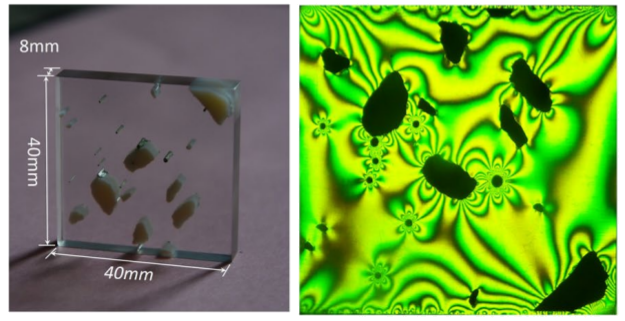3D printed samples
When the sample shape is too complex so that a backing mold cannot be made to cast the photoelastic sample it is still possible to directly 3D print it. 3D printing is not simple and it is even worse when you have to do it with a photoelastic material making sure there is no residual stresses. That is why you should not expect this way to make photoelastic samples to be the ultimate one. It is good if you want to work with hard material (high loading) and that you can afford expensive samples. Also if you want to rapidly prototype a photoelastic sample and if your measurement accuracy is not too high, it still worth. In this section we go more into details about this method and the different options.
Stereolithography
The easiest and most democratic way to 3D print photoelastic samples is to use stereolithography. However, even if it does not induce residual stresses you end up having a stiff and not very transparent material so that it is barely usable. In the picture below where the sample have been printed with a Form-2 from Formlabs, even by bending strongly the sample, photoelastic response is rather weak and blurry. So this method is only valid for large loading when you just expect a qualitative measurement.
Fused Filament Fabrication
To 3D printing a photoelastic sample another option exists: using Fused Filament Fabrication technology with transparent material. Generally speaking, this is not the best option with a cheap 3D printer since it induces a lot of residual stresses and porosity that make the sample barely transparent. Still, the company Stratasys proposes a quite recent material called Veroclear which is perfectly clear and as photoelastic (and stiff) as plexiglass. Another option is to use Durus White 430 which is less transparent but also less expensive. Veroclear has been used to make photoelastic samples here and here by Yang Ju and co-workers while Durus White has been used by Osvanny Ramos and co-workers here to make photoelastic granular matter. The main drawback here is that these materials are very stiff and expensive just like the printing technology.

Pictures of a Veroclear sample in normal light and under compression between crossed polarisers extracted from here.